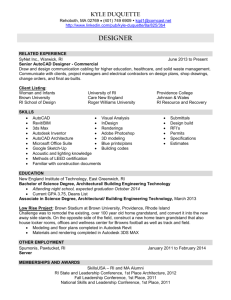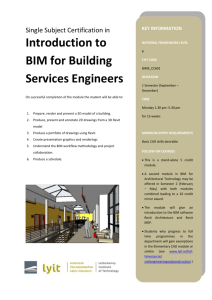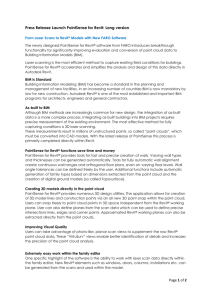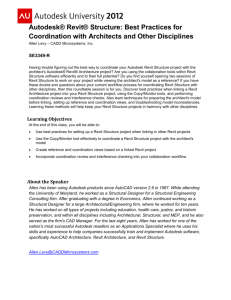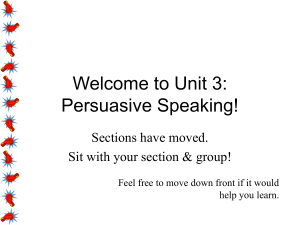Instructor: Chiu-Shui Chan, Ph.D., Professor of Architecture/VRAC/HCI Office:
advertisement
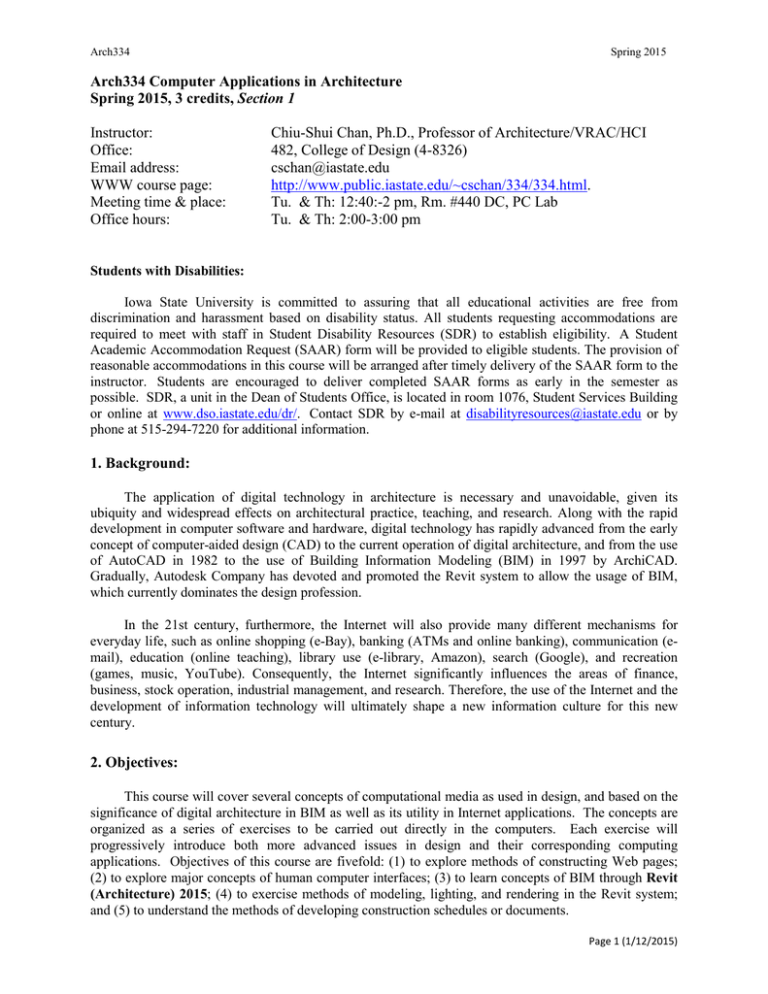
Arch334 Spring 2015 Arch334 Computer Applications in Architecture Spring 2015, 3 credits, Section 1 Instructor: Office: Email address: WWW course page: Meeting time & place: Office hours: Chiu-Shui Chan, Ph.D., Professor of Architecture/VRAC/HCI 482, College of Design (4-8326) cschan@iastate.edu http://www.public.iastate.edu/~cschan/334/334.html. Tu. & Th: 12:40:-2 pm, Rm. #440 DC, PC Lab Tu. & Th: 2:00-3:00 pm Students with Disabilities: Iowa State University is committed to assuring that all educational activities are free from discrimination and harassment based on disability status. All students requesting accommodations are required to meet with staff in Student Disability Resources (SDR) to establish eligibility. A Student Academic Accommodation Request (SAAR) form will be provided to eligible students. The provision of reasonable accommodations in this course will be arranged after timely delivery of the SAAR form to the instructor. Students are encouraged to deliver completed SAAR forms as early in the semester as possible. SDR, a unit in the Dean of Students Office, is located in room 1076, Student Services Building or online at www.dso.iastate.edu/dr/. Contact SDR by e-mail at disabilityresources@iastate.edu or by phone at 515-294-7220 for additional information. 1. Background: The application of digital technology in architecture is necessary and unavoidable, given its ubiquity and widespread effects on architectural practice, teaching, and research. Along with the rapid development in computer software and hardware, digital technology has rapidly advanced from the early concept of computer-aided design (CAD) to the current operation of digital architecture, and from the use of AutoCAD in 1982 to the use of Building Information Modeling (BIM) in 1997 by ArchiCAD. Gradually, Autodesk Company has devoted and promoted the Revit system to allow the usage of BIM, which currently dominates the design profession. In the 21st century, furthermore, the Internet will also provide many different mechanisms for everyday life, such as online shopping (e-Bay), banking (ATMs and online banking), communication (email), education (online teaching), library use (e-library, Amazon), search (Google), and recreation (games, music, YouTube). Consequently, the Internet significantly influences the areas of finance, business, stock operation, industrial management, and research. Therefore, the use of the Internet and the development of information technology will ultimately shape a new information culture for this new century. 2. Objectives: This course will cover several concepts of computational media as used in design, and based on the significance of digital architecture in BIM as well as its utility in Internet applications. The concepts are organized as a series of exercises to be carried out directly in the computers. Each exercise will progressively introduce both more advanced issues in design and their corresponding computing applications. Objectives of this course are fivefold: (1) to explore methods of constructing Web pages; (2) to explore major concepts of human computer interfaces; (3) to learn concepts of BIM through Revit (Architecture) 2015; (4) to exercise methods of modeling, lighting, and rendering in the Revit system; and (5) to understand the methods of developing construction schedules or documents. Page 1 (1/12/2015) The goal of this course is to learn skills sufficient to operate BIM in design representation, to use the Internet for displaying design thoughts and models on the Web, and to develop some concepts regarding the manipulation of computers as design tools. 3. Assignments: There are four homework assignments, which are designed to familiarize you with software applications. Since you will learn design methods in other courses, the assignments focus on computational aspects of computer-aided design (CAD). The following assignments, depending upon the level of difficulty and time consumed, will have different weights. *Assignment #1: *Assignment #2-1: *Assignment #2-2: *Assignment #3: *Assignment #4: *Lab exercises: 15 points – Web page design & research on digital model 10 points – ACAD 2D drawing for site plan 20 points – Apply ACAD 2D for Revit site modeling 30 points – Revit modeling and rendering 15 points – Documentation and scheduling 10 points – In class hands-on exercises 4. Class attendance Class attendance is critical for the final grade. More than three unexcused absences during the course of the semester may either result in the reduction of the semester grade, or fail the course. Please turn off your cell phone in the class. It is not respectful to answer cell phone calls or send text message in class. 5. Final Grade: All assignments will be due on the date shown in the class schedule on page 4. It is recommended to place all the required materials in a folder, put your name on the folder and hand it in. Late submissions will not be accepted, and no incomplete will be given. Please do assignments by carefully following the criteria and accomplishing the requirements listed on handouts. Any missing part will lose points. The final grade is in proportion to the effort spent on the assignments and the participation in the class. It is totaled from the assignment scores, and determined roughly by the combination of the following scale and the score distribution: 90 and up: 80 and up: 70 and up: 60 and up: Below 60: A B C D F Note: Submitting plagiarized work is a violation of personal and academic integrity. The issue I am addressing here is an issue of basic integrity and academic honor that needs to be respected in an academic community. 6. Technical Information: Software and Hardware: We shall use publicly available software throughout the term. All Page 2 (1/12/2015) Arch334 Spring 2015 assignments can be completed on machines located in the Design Center or at home if you have your own machine and software. There are on-line helps and references available in each system, which provide detailed explanations on each commands and functions. Classroom and Lab: The class will meet every Tuesday and Thursday for 90 minutes. The PC-CAD Lab will open most of the time throughout the semester. Please check with the lab monitors to find out schedule details. Student Responsibilities: Please handle the equipment with care and report all problems to the monitor in charge. Always keep two copies of your work -- one is used as a working copy, the other one is for a backup. Also save and backup your work every 30 minutes. This will avoid problems that may arise in a software error, machine crash, or power failure. Otherwise, you might accidentally have a bad dream. Computer Ethics: 1. Please delete your personal files from the desktop each time before you leave or logout the machine. This will protect the privacy/copyright of your own models. 2. If you changed or redefined the environment setting of the software system, please change it back to its original value after you finished your work before you leave. This will avoid confusing other users' work – because the environmental settings will be kept in the system per machine. 7. General Guidelines: 1. A cardinal rule of computing is, "If you don't know how to do something, find it out from manuals, textbooks, or some trials." Usually, manuals and textbooks provide detailed step-bystep guides and procedures. Trials with thoughts may enhance problem solving ability, although wild guessing may sometimes cause problems. 2. All assignments shall be due on the dates noted on this handout. Extensions will not be given primarily because that extension will affect your work and participation in other parts of the course. 3. Back up your work and save your files every 30 minutes. 4. Each lab exercise is required to be loaded to K drive / 334 folder, which will be used as a part of final grade evaluation. 8. Textbook and Suggested Reading: The text book is "Mastering Autodesk Revit Architecture 2015" by Eddy Krygiel and James Vandezande, Sybex Publishing, ISBN-13: 978-1118862858 • • • • Revit page: http://www.autodesk.com/products/revit-family/overview. This page provides various information on hardware and software relating to the application of Revit. Online help and user guides: http://help.autodesk.com/view/RVT/2015/ENU/ - a WikiHelp window with tips & video for versions 2015. Information about Revit family/objects: http://revit.autodesk.com/library/html/index.html. All the library items could be found through the Autodesk Seek search engine. Its Web address is: http://seek.autodesk.com/. Another resourceful place that could download Revit families, ask questions and share ideas is Revit city, its Web address is: http://www.revitcity.com/index.php, or http://www.revitcity.com/gallery.php. Use Google search to find more related families. Page 3 (1/12/2015) • • Video tutorial clips, which are useful for beginners and some are free, could be found on the Web at: http://www.lynda.com/. Some good ACAD/Revit models and examples of homework assignments done previously are provided on the Web at: http://www.public.iastate.edu/~cschan/334/334.html. 9. Tentative Class Schedule (will be changed as necessary) January 13 Lect 1: Course introduction --Web page setup --HTML example January 15 Lect 2: Intro to Web -- Web page set up -- Dreamweaver Assignment 1 issued January 20 Lect 3: -- Dreamweaver -- Upload files January 22 Work session January 27 Assignment 1 due January 29 Lect 4: --Concept of Layer -- Block and drawing February 3 Lect 5: -- ACAD Interface February 5 Lect 6: -- Concept of BIM February 10 Lect 7: Revit Modeling --Setup February 12 Lect 8: -- Revit grid pattern Assignment 2 issued February 17 Lect 9: -- Revit site studies February 19 Lect 10: -- Revit site modeling March 5 Lect 14: -- Door family March 10 Lect 15: --Wall & Stair March 24 Assignment 2 due March 26 Lect 17: --Roof February 24 Lect 11: -- Modeling edit -- Project site due. March 12 Lect 16: --Railing & structure February 26 Lect 12: -- Revit massing March 3 Lect 13: --System Family - March 17 Spring break March 19 Spring break March 31 Lect 18: -- Revit material April 2 Lect 19: --Sun & Shadow April 16 Lect 21: -- Room Tag -- Schedules April 21 Lect 22: --Door Tag --Schedule April 7 Lect 20: --Background image Assignment 3 issued April 9 --Work session April 14 Assignment 3 due April 23 Lect 23: --Cost estimate Final project issued April 28 Lect 24: --Summaries April 30 Jury week. May 4 Final presentation 2:15-4:15pm. Work session Tutoring Work session Tutoring Final project due. Assignment 1: Internet Design (15) Assignment 3: Revit modeling and rendering (30) Page 4 (1/12/2015) Assignment 2: Revit site and ground floor level modeling (35) Assignment 4: Revit scheduling, document & presentation (20)
